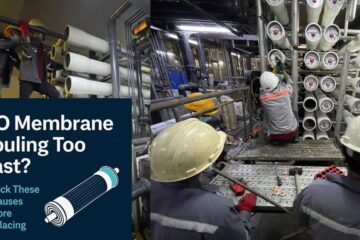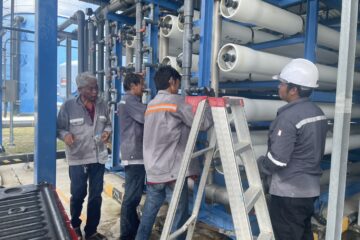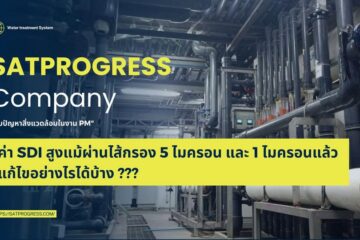Clean-in-Place (CIP) is an essential maintenance process for Reverse Osmosis (RO) systems, designed to keep membranes clean and functioning optimally. Failure to conduct regular CIP procedures can lead to various issues that affect both the performance and longevity of RO membranes. Here’s a look at the potential problems that arise when CIP is neglected:
1. Membrane Fouling
Membrane fouling is one of the primary issues that occur when CIP is not performed. Fouling can be caused by several types of contaminants:
- Scaling (Inorganic Fouling): Deposition of salts like calcium carbonate and calcium sulfate, which obstruct water flow and increase pressure across the membrane.
- Organic Fouling: Accumulation of organic materials like proteins, oils, and fats that reduce membrane permeability.
- Biofouling: Growth of microorganisms like bacteria and algae, which can create biofilms on membrane surfaces.
Without regular cleaning, these deposits will build up, causing significant performance degradation and even permanent damage.
2. Reduced Water Permeability and Efficiency
As fouling accumulates, the permeability of the RO membrane decreases. This means that more energy is required to push water through the membrane, leading to increased operational costs. Over time, this reduces the overall efficiency of the system, which directly impacts the quality and quantity of the treated water.
3. Increased Energy Consumption
Membrane fouling causes higher pressure to be applied to maintain the same water output. As a result, the energy consumption of the RO system increases. This not only raises the cost of operation but also places a greater strain on the system’s components, leading to more frequent breakdowns.
4. Shortened Membrane Lifespan
Neglecting CIP can lead to irreparable damage to the RO membranes. Over time, severe fouling can cause irreversible blockages, rendering the membrane ineffective. This results in the need for early membrane replacement, which is a costly and time-consuming process.
5. Deterioration of Water Quality
As the RO membranes become fouled, their ability to filter out contaminants diminishes. This can lead to poor water quality, with higher levels of dissolved solids, microorganisms, and organic compounds in the treated water. In industries that rely on high-purity water, this could have serious operational implications, including contamination of processes or products.
6. Higher Maintenance Costs
Without regular CIP, RO systems may require more frequent maintenance and unplanned repairs. Fouling leads to component stress, which can cause premature failure of pumps, valves, and other equipment. The cost of emergency repairs, unplanned downtime, and membrane replacement can be significantly higher than the cost of regular CIP.
Conclusion
Failure to perform regular Clean-in-Place procedures on RO systems can result in numerous issues, from reduced efficiency and increased energy consumption to irreversible membrane damage and poor water quality. Regular CIP not only extends the life of the membrane but also maintains optimal system performance, ensuring cost-effective and reliable operation. Proper CIP protocols are, therefore, a critical part of maintaining RO systems.
ผลกระทบหากไม่ทำการ CIP ในระบบ RO
Clean-in-Place (CIP) เป็นกระบวนการบำรุงรักษาที่สำคัญของระบบ Reverse Osmosis (RO) ที่ช่วยทำความสะอาดเมมเบรนและทำให้ระบบทำงานอย่างเต็มประสิทธิภาพ การไม่ทำ CIP อย่างสม่ำเสมออาจส่งผลกระทบต่อระบบ RO อย่างมาก ดังนี้:
1. การเกิดการฟาวล์ในเมมเบรน (Membrane Fouling)
การไม่ทำ CIP จะทำให้เมมเบรนเกิดการฟาวล์ ซึ่งมีหลายประเภท:
- การเกิดตะกรัน (Inorganic Fouling): การสะสมของเกลือแร่ เช่น แคลเซียมคาร์บอเนต และแคลเซียมซัลเฟต ทำให้การไหลของน้ำถูกขัดขวาง
- การฟาวล์จากสารอินทรีย์ (Organic Fouling): เกิดจากการสะสมของโปรตีน ไขมัน และน้ำมัน ซึ่งลดความสามารถในการซึมผ่านของเมมเบรน
- การฟาวล์จากจุลินทรีย์ (Biofouling): การเจริญเติบโตของแบคทีเรียและสาหร่าย ทำให้เกิดการสะสมของไบโอฟิล์มบนพื้นผิวเมมเบรน
การสะสมเหล่านี้จะลดประสิทธิภาพการทำงานของระบบ RO และอาจทำให้เมมเบรนเสียหายถาวรหากไม่ทำ CIP อย่างสม่ำเสมอ
2. ประสิทธิภาพในการซึมผ่านของน้ำลดลง
เมื่อเมมเบรนเกิดการฟาวล์ การซึมผ่านของน้ำจะลดลง ทำให้ต้องใช้พลังงานมากขึ้นในการกรองน้ำ ซึ่งจะเพิ่มต้นทุนการดำเนินงานและลดประสิทธิภาพการกรอง
3. การใช้พลังงานเพิ่มขึ้น
การฟาวล์ของเมมเบรนทำให้ต้องเพิ่มความดันในการกรองน้ำ ส่งผลให้การใช้พลังงานเพิ่มขึ้น นอกจากนี้ การเพิ่มความดันยังทำให้ระบบมีโอกาสเสียหายมากขึ้น
4. อายุการใช้งานของเมมเบรนสั้นลง
หากไม่มีการทำ CIP เมมเบรนจะเกิดการอุดตันอย่างถาวร และจะต้องเปลี่ยนเมมเบรนใหม่ซึ่งมีค่าใช้จ่ายสูง
5. คุณภาพน้ำที่กรองได้ต่ำลง
เมมเบรนที่ถูกฟาวล์จะไม่สามารถกรองน้ำได้อย่างมีประสิทธิภาพ ทำให้น้ำที่กรองได้มีสารเจือปนสูงขึ้น เช่น สารละลายแขวนลอย หรือจุลินทรีย์ที่ไม่พึงประสงค์
6. ค่าใช้จ่ายในการบำรุงรักษาสูงขึ้น
ระบบ RO ที่ไม่มีการทำ CIP จะต้องบำรุงรักษาและซ่อมแซมบ่อยขึ้น ซึ่งค่าใช้จ่ายในการซ่อมแซมและเปลี่ยนชิ้นส่วนจะสูงกว่าการทำ CIP อย่างสม่ำเสมอ
บทสรุป
การไม่ทำ CIP ในระบบ RO จะนำไปสู่ปัญหามากมาย ทั้งการฟาวล์ของเมมเบรน การใช้พลังงานสูง และการลดอายุการใช้งานของเมมเบรน การทำ CIP อย่างสม่ำเสมอไม่เพียงแต่ช่วยยืดอายุการใช้งานของเมมเบรน แต่ยังช่วยรักษาประสิทธิภาพของระบบ RO ให้ทำงานได้ดีอยู่เสมอ
GET IN TOUCH



0 Comments